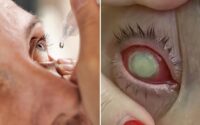Thirdhand smoke can cause cancer, too: shocking study
While inhaling secondhand smoke is known to have ill effects, even handling a smoker’s clothes could potentially cause cancer.
A new study conducted by the Lawrence Berkeley National Laboratory discovered the presence of smoke on items and clothes — called thirdhand smoke — can cause cancer due to its contamination from toxins.
The research team had previously studied the effects of smoking and vaping inside and found that surfaces can absorb the residue, which carries dangerous toxins, and persist.
Tobacco-specific nitrosamines (TSNAs) are created as a result of the toxins reacting with nitrous acid in the air, which were examined as part of the study published in the journal Environmental Science & Technology.
Touching surfaces and air, inhaling particles or ingesting dust are among the ways TSNAs can enter the body, where they can remain for days after contact. Sleeping on smoky bed sheets, for example, is one method of TSNA exposure.

“Since we first described this chemistry in 2010, several studies have further illustrated the presence of TSNAs on indoor surfaces and settled dust,” Berkeley lab chemist Hugo Destaillats said in a media release.
Destaillats said researchers used information collected over the past decade “to estimate the daily doses to which people may be exposed when living in homes contaminated with thirdhand smoke.”
“Nicotine is released in large amounts during smoking, and it coats all indoor surfaces, including human skin,” Xiaochen Tang, the experience leader, said in the press release, adding that skin oils and sweat actually “led to a higher yield of TSNAs” while in the presence of nitrous acid.
Two types of carcinogenic TSNAs can be formed through indoor smoking, known as NNK and NNN. A third kind, known as NNA, was also studied, although it isn’t present in tobacco smoke.

“We present additional evidence of the genotoxicity of NNA by evaluating its effect on cultured human lung cells,” said study co-author Bo Hang. “Contact with NNA led to DNA damage, including double-strand breaks, the most deleterious genotoxic outcome.”
Tested in mice, rats, hamsters and mink, researchers noted that NNK caused cancer, including of the liver, lung and pancreas, suggesting that its presence could have toxic effects on humans. Even after not being around tobacco smoke or contaminated surfaces, researchers discovered the toxins can remain in the blood for days.
In fact, under “typical indoor conditions,” scientists found the NNK doses exceeded health guidelines found in California’s Office of Environmental Health Hazard Assessment. Per Proposition 65, NNK levels were found to be above “No-Significant Risk Levels,” which increases the risk of developing cancer.
“These findings illustrate the potential health impacts of thirdhand smoke, which contains not only TSNAs but hundreds of other chemicals, some of which are also known carcinogens,” said co-author Neal Benowitz, a UCSF professor who leads the Consortium. “Next steps for this research will explore in more detail the mechanisms of adverse health effects associated with tobacco and cannabis residues, effective remediation strategies, and translation of scientific findings to tobacco control practice.”


